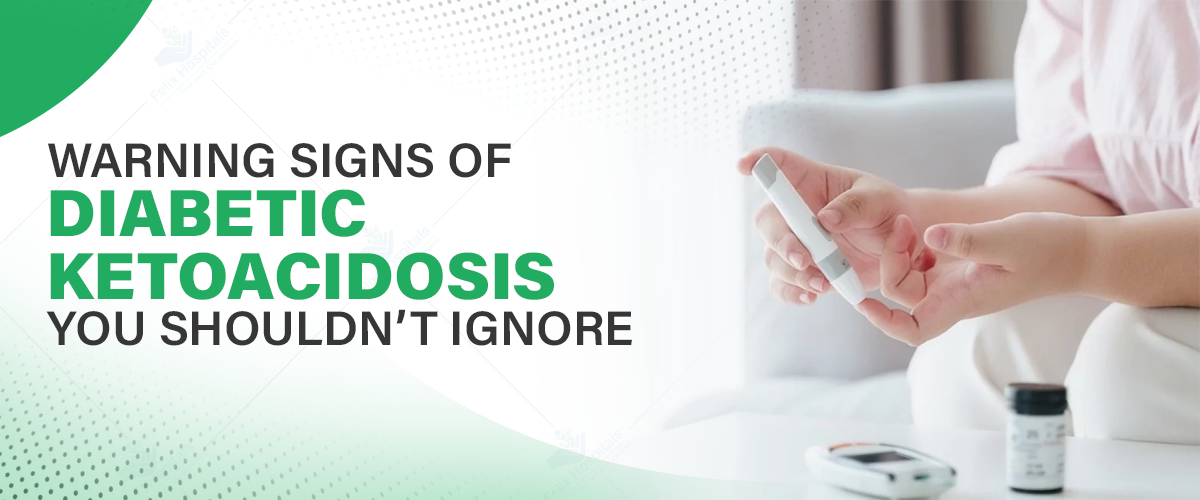
Subscribe to our

If you've been diagnosed with diabetes, it’s important that you know what are the warning signs of Diabetes Ketoacidosis. Diabetes Ketoacidosis (DKA) is a serious and life-threatening condition that can occur in people with diabetes, primarily caused due to lack of insulin production and high levels of blood acids called ketones. DKA is most common in individuals with type 1 diabetes but can also occur in individuals with type 2 diabetes under specific conditions. Let’s take a closer look at the warning signs of Diabetic Ketoacidosis as high levels of ketones can poison the body.
Treatment for DKA usually requires hospitalization, but you can prevent it by learning the early symptoms and warning signs such as extreme thirst, high blood glucose levels, and frequent urination. DKA usually develops slowly, however, when vomiting occurs, this life-threatening condition can develop in a few hours.
At Felix Hospitals, the best endocrinology hospital in Noida, our endocrinology experts are equipped to provide accurate diabetes diagnosis and advanced treatment. For appointments, contact: +(91) 9667064100
DKA occurs when there is a lack of insulin production in the body. Basically when the body doesn’t have enough insulin, it cannot process sugar that’s used for energy. As a result, the body starts to break down fat, which in turn releases ketones. So ketones are produced whenever the body uses fat for energy.
As a result, ketones make your blood acidic and if the treatment is delayed, this can lead to:
Several factors can contribute to the onset of Diabetic Ketoacidosis. In fact, DKA is sometimes the first sign of type 1 diabetes in people who have not yet been diagnosed. Some of the common causes include:
High blood glucose (blood sugar) levels is one of the early symptoms of DKA, however, there is no one level that triggers ketoacidosis. The level may vary from person to person. That said, in general, DKA begins when blood sugar levels exceed 250 mg/dL. So, if your blood sugar level exceeds this level, contact your diabetologist immediately.
DKA occurs when a person has less insulin than their body needs to process the amount of sugar in the blood. Basically, low insulin levels lead to DKA.
Insulin allows us to convert blood sugar into energy. Without enough insulin the body cannot produce enough energy from blood sugar. Because of this the blood sugar becomes very high, and the liver turns fat into ketones which supply some energy, a process called ketosis.
As mentioned, DKA can become complicated and life-threatening if not treated on time. If you are diabetic, it's important for you to know the early warning signs, that include:
Other symptoms that will follow includes:
Diagnosis of DKA involves blood tests to measure acid levels, blood sugar, and ketones. Diabetes patients can check ketones at home with home kits available over the counter. Some glucose meters can also test for ketones in the blood sample when patients do a finger prick.
Common tests to diagnose DKA include:
Treatment for DKA is complex, and patients with DKA need to be admitted to the intensive care unit, for careful monitoring. The primary goal of DKA treatment is to stabilize high blood sugar levels with insulin and correct metabolic imbalances. This involves:
Felix Hospital is recognized as one of the best Endocrinology hospitals in Noida. We have a team of experienced endocrinologists and diabetologists dedicated to providing top-notch care for diabetes and its complications, including Diabetic Ketoacidosis. Our team, led by Dr Vimal Gupta, uses advanced diagnostic tools and evidence-based treatments to ensure patient safety and recovery.
Whether you’re seeking preventive advice or emergency care, Felix Hospitals offers comprehensive support for managing diabetes and maintaining endocrine health. Schedule an appointment today to meet the best doctors in the field.
Book a consultation with our endocrinology team for expert care and personalized treatment plans for diabetes and its complications.
Diabetic Ketoacidosis can be a life-threatening condition but by understanding the early warning signs of Diabetic Ketoacidosis, individuals with diabetes can minimize their risk of developing the condition.
1. Who is at risk of DKA?
Ans: People with type 1 diabetes are at the highest risk, but it can also occur in individuals with type 2 diabetes under certain conditions.
2. Can dehydration cause DKA?
Ans: DKA is a state of insulin deficiency. The life threatening condition can be aggravated by dehydration.
3. Can DKA be prevented?
Ans: Yes, by managing blood sugar levels, taking insulin as prescribed, and monitoring for ketones during illness or stress.
4. Can a diabetic survive without insulin?
Ans: Without insulin, a diabetes patient could develop diabetic ketoacidosis (DKA). This is a life-limiting condition.
5. What are signs of a diabetic emergency?
Ans: Someone who is hypoglycaemic (having a low blood sugar) may have symptoms including: sweating, feeling drowsy and confused, unconscious and unresponsive.